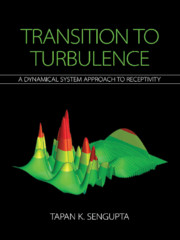Book contents
- Frontmatter
- Dedication
- Contents
- Preface
- 1 Receptivity, Instability, and Transition: A Perspective
- 2 Dynamical System Theory and Role of Equilibrium Flows
- 3 Fundamentals of Scientific Computing
- 4 Instability and Transition
- 5 Receptivity Analysis: Relation with Instability Experiments
- 6 Dynamical System Theory of Linear Receptivity
- 7 Nonlinear, Nonparallel Effects on Receptivity, Instability, and Transition
- 8 Three-Dimensional Routes of Transition to Turbulence
- 9 Receptivity to Free Stream Excitation: Theory, Computations, and Experiments
- 10 Nonlinear Receptivity Theories: Hopf Bifurcations and Proper Orthogonal Decomposition for Instability Studies
- 11 Mixed Convection Flow
- 12 Baroclinic Instability: Rayleigh–Taylor Instability
- 13 Coherent Structure Tracking in Transitional and Turbulent Flows
- 14 The Route of Transition to Turbulence: Solution of Global Nonlinear Navier–Stokes Equation
- References
6 - Dynamical System Theory of Linear Receptivity
Published online by Cambridge University Press: 16 February 2021
- Frontmatter
- Dedication
- Contents
- Preface
- 1 Receptivity, Instability, and Transition: A Perspective
- 2 Dynamical System Theory and Role of Equilibrium Flows
- 3 Fundamentals of Scientific Computing
- 4 Instability and Transition
- 5 Receptivity Analysis: Relation with Instability Experiments
- 6 Dynamical System Theory of Linear Receptivity
- 7 Nonlinear, Nonparallel Effects on Receptivity, Instability, and Transition
- 8 Three-Dimensional Routes of Transition to Turbulence
- 9 Receptivity to Free Stream Excitation: Theory, Computations, and Experiments
- 10 Nonlinear Receptivity Theories: Hopf Bifurcations and Proper Orthogonal Decomposition for Instability Studies
- 11 Mixed Convection Flow
- 12 Baroclinic Instability: Rayleigh–Taylor Instability
- 13 Coherent Structure Tracking in Transitional and Turbulent Flows
- 14 The Route of Transition to Turbulence: Solution of Global Nonlinear Navier–Stokes Equation
- References
Summary
Introduction
One of the principal tenets in developing a dynamical system theory is to study the relationship between cause and effects. This is true for a fluid dynamical system characterized by a large number of degrees of freedom, as compared to other dissipative dynamical systems in many fields of physics. Experimental verification of any theory is imperative, and in this respect, theories of instabilities are difficult propositions. This is because instability theories rely on omnipresent imperceptible ambient disturbances as input to produce response, specifically in the limit of vanishingly small input that is needed in the dynamical system approach. Mathematically, the instability problem involves seeking the output of a system governed by a homogeneous differential equation, subject to a homogeneous boundary and initial conditions. Implicit in this is the requirement of an equilibrium state whose instability is studied, and for which imperceptible omnipresent disturbance resides and draws energy for its growth. For example, flow past a circular cylinder displays unsteadiness above a critical Reynolds number (based on oncoming flow speed and diameter of the cylinder), even when one is considering uniform flow over a perfectly smooth cylinder. Whereas this can be rationalized for experimental investigation where the presence of background disturbances cannot be ruled out, the situation is far from straightforward for computational efforts. Roles of various numerical sources of error triggering instability for uniform flow past a smooth circular cylinder is complicated. This issue has been dealt with in [469]. Inability to compute the equilibrium flow past a circular cylinder at relatively high Reynolds numbers is due to the presence of adverse pressure gradient experienced by the flow on the lee side of the cylinder. The situation is equally difficult for the flow over a very long flat plate. As the equilibrium flow is obtained with significant precision, it is possible to study the flow past a flat plate as a receptivity problem, as has been done experimentally to study the existence of TS waves by Schubauer and Skramstad [405], where the disturbances were created by a vibrating ribbon inside the boundary layer.
We have already identified a few drawbacks of the linear instability theory formulated by a homogeneous governing equation with homogeneous boundary conditions, in search of eigenvalues to explain growth of disturbances.
- Type
- Chapter
- Information
- Transition to TurbulenceA Dynamical System Approach to Receptivity, pp. 194 - 211Publisher: Cambridge University PressPrint publication year: 2021



